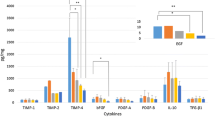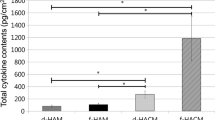Abstract
Air-dried and sterilized amnion has been widely used as a dressing to treat burn and partial thickness wounds. Sterilisation at the standard dose of 25 kGy was reported to cause changes in the morphological structure as observed under the scanning electron microscope. This study aimed to quantify the changes in the ultrastructure of the air-dried amnion after gamma-irradiated at several doses by using atomic force microscope. Human placentae were retrieved from mothers who had undergone cesarean elective surgery. Amnion separated from chorion was processed and air-dried for 16 h. It was cut into 10 × 10 mm, individually packed and exposed to gamma irradiation at 5, 15, 25 and 35 kGy. Changes in the ultrastructural images of the amnion were quantified in term of diameter of the epithelial cells, size of the intercellular gap and membrane surface roughness. The longest diameter of the amnion cells reduced significantly after radiation (p < 0.01) however the effect was not dose dependent. No significant changes in the shortest diameter after radiation, except at 35 kGy which decreased significantly when compared to 5 kGy (p < 0.01). The size of the irradiated air-dried amnion cells reduced in the same direction without affecting the gross ultrastructure. At 15 kGy the intercellular gap decreased significantly (p < 0.01) with Ra and Rq, values reflecting surface roughness, were significantly the highest (p < 0.01). Changes in the ultrastructure quantified by using atomic force microscope could complement results from other microscopic techniques.




Similar content being viewed by others
References
AATB (2008) Standards for tissue banking, 12th edn. American Association of Tissue Banks, Virginia
Boo L, Sofiah S, Selvaratnam L, Tai CC, Murphy BP, Kamarul T (2009) A preliminary study of human amniotic membrane as a potential chondrocyte carrier. Malays Orthop J 3(2):16–23. https://doi.org/10.5704/MOJ.1711.008
Bujang SE, Halim AS, Khoo TL, Dorai AA (2010) Dried irradiated human amniotic membrane as biological dressing for facial burns—a 7-year case series. Burns 36(6):876–882. https://doi.org/10.1016/j.burns.2009.07.001
Chen Q, Xiao P, Chen JN, Cai JY, Cai XF, Ding H, Pan YL (2010) AFM studies of cellular mechanics during osteogenic diffentiation of human amniotic fluid-derived stem cells. Anal Sci 26(10):1033–1037
Cooper LJ, Kinoshita S, German M, Koizumi N, Nakamura T, Fullwood NJ (2005) An investigation into the composition of amniotic membrane used for ocular surface reconstruction. Cornea 24(6):722–729
Deocaris CC, Abad LB, Enriquez EP, Guzman ZMD, Aliganga AA, Tangonan MB, Tolentino MM, Ignacio LV, Deocaris CC (2005) Radiolytic damage to freeze-dried human amniotic membrane. Philipp J Sci 134(1):45–50
Eskandarlou M, Azimi M, Rabiee S, Seif RMA (2016) The healing effect of amniotic membrane in burn patients. World J Plast Surg 5(1):39–44
Ficicoglu C, Ozden S, Kavak Z, Okar I (1998) Effects of active labour on the ultrastructure of amnion epithelium. Med Sci Res 26(2):135–139
Frangouli O, Adams GG (2013) The use of amniotic membrane for the management of fibrosis in complex strabismus surgery. Strabismus 21(1):13–22. https://doi.org/10.3109/09273972.2012.762531
Gut G, Marowska J, Jastrzebska A, Olender E, Kamiński A (2016) Structural mechanical properties of radiation-sterilized human Bone–Tendon–Bone grafts preserved by different methods. Cell Tissue Bank 17(2):277–287. https://doi.org/10.1007/s10561-015-9538-1
Hamid SS, Zahari NK, Yusof N, Hassan A (2014) Scanning electron microscope assessment on surface morphology of preserved human membrane after gamma sterilisation. Cell Tissue Bank 15(1):15–24. https://doi.org/10.1007/s10561-012-9353-x
Hasse K, Pelling AE (2015) Investigating cell mechanics with atomic force microscopy. J R Soc Interface 12(104):20140970. https://doi.org/10.1098/rsif.2014.0970
Heu C, Berquand A, Elie-Caille C, Nicod L (2012) Glyphosate-induced stiffening of hacat keratinocytes, a peak force tapping study on living cells. J Struct Biol 178(1):1–7. https://doi.org/10.1016/j.jsb.2012.02.007
Hilmy N, Siddik S, Gentur S, Gulardi W (1987) Physical and chemical properties of freeze-dried amnion chorion membranes sterilized by γ-Irradiation. Atom Indones 13(2):1–14
Hoh JH, Sosinsky GE, Revel JP, Hansma PK (1993) Structure of the extracellular surface of the gap junction by atomic force microscopy. Biophys J 65(1):149–163
Iwasaki R, Matsubara S, Takizawa T, Takayama T, Yashiro T, Suzuki M (2003) Human amniotic epithelial cells are morphologically homogenous: enzymehistochemical, tracer, and freeze-substitution fixation study. Eur J Histochem 47(3):223–232
Kamalia NZ, Suzina SABH, Yusof N (2014) Changes in biophysical properties of human amniotic membranes after different preservation methods and radiation sterilization. Regen Res 3(1):64–70
Kanthan SR, Ganesan K, Azura M, Kamarul T (2010) The difference preparations of human amniotic membrane (HAM) as a potential cell carrier for condrocytes. Eur Cell Mater 20(2):46
Kasas S, Longo G, Dietler G (2013) Mechanical properties of biological specimens explored by atomic force microscopy. J Phys D Appl Phys 46(13):133001
Kaul-Ghanekar R, Singh S, Mamgain H, Badhwar AJ, Paknikar KM, Chattopadhyay S (2009) Tumor suppressor protein SMAR 1 modulates the roughness of cell surface: combined AFM and SEM study. BMC Cancer 9:350. https://doi.org/10.1186/1471-2407-9-350
Krishnamurithy G, Shilpa PN, Ahmad RE, Sulaiman S, Ng CLL, Kamarul T (2011) Human amniotic membrane as a chondrocyte carrier vehicle/substrate: in vitro study. J Biomed Mater Res A 99(3):500–506. https://doi.org/10.1002/jbm.a.33184
Lo V, Lara-Corrales I, Stuparich A, Pope E (2010) Amniotic membrane grafting in patients with epidermolysis bullosa with chronic wounds. J Am Acad Dermatol 62(6):1038–1044. https://doi.org/10.1016/j.jaad.2009.02.048
Loeffelbein DJ, Baumann C, Stoeckelhuber M, Hasler R, Mücke T, Steinsträßer L, Drecoll E, Wolff KD, Kesting MR (2012) Amniotic membrane as part of a skin substitute for full thickness wounds: an experimental evaluation in a porcine model. J Biomed Mater Res B Appl Biomater 100(5):1245–1256. https://doi.org/10.1002/jbm.b.32689
Mamede AC, Carvalho MJ, Abrantes AM, Laranjo M, Maia CJ, Botelho MF (2012) Amniotic membrane: from structure and functions to clinical applications. Cell Tissue Res 349(2):447–458. https://doi.org/10.1007/s00441-012-1424-6
Manjas M, Tarusaraya P, Hilmy N (2010) Clinical applications of irradiated amnion grafts. In: Nather A, Yusof N, Hilmy N (eds) Allograft procurement, processing and transplantation—a comprehensive guide for tissue banks. World Scientific Publishing, Singapore, pp 501–515
Miyagawa A, Kobayashi M, Fujita Y, Nakamura M, Hirano K, Kobayashi K, Miyake Y (2000) Surface topology of collagen fibrils associated with proteoglycans in mouse cornea and sclera. Jpn J Ophthalmol 44(6):591–595
Mohamad H (2010) Amnion processing. In: Nather A, Yusof N, Hilmy N (eds) Allograft procurement, processing and transplantation—a comprehensive guide for tissue banks. World Scientific Publishing, Singapore, pp 361–367
Nguyen H, Cassady AI, Bennett MB, Gineyts E, Wu A, Morgan DA, Forwood MR (2013) Reducing the radiation sterilization dose improves mechanical and biological quality while retaining sterility assurance levels of bone allografts. Bone 57(1):194–200. https://doi.org/10.1016/j.bone.2013.07.036
Niknejad H, Peirovi H, Jorjani M, Ahmadiani A, Ghanavi J, Seifalian AM (2008) Properties of the amniotic membrane for potential use in tissue. Eur Cell Mater 15:88–99
Singh R, Chacharkar MP (2011) Dried gamma-irradiated amniotic membrane as dressing in burn wound care. J Tissue Viability 20(2):49–54. https://doi.org/10.1016/j.jtv.2010.06.001
Singh R, Purohit S, Chacharkar MP (2007) Effect of high doses of gamma radiation on the functional characteristics of amniotic membrane. Radiat Phys Chem 76(6):1026–1030. https://doi.org/10.1016/j.radphyschem.2006.09.010
Sonek J, Gabbe SG, Iams JD, Kniss DA (1991) Morphologic changes in the human amnion epithelium that accompany labor as seen with scanning and transmission electron microscopy. Am J Obstet Gynecol 164(1):1174–1180
Tan SL, Sulaiman S, Pingguan-Murphy B, Selvaratnam L, Tai CC, Kamarul T (2011) Human Amnion as a novel cell delivery vehicle for chondrogenic mesenchymal stem cells. Cell Tissue Bank 12(1):59–70. https://doi.org/10.1007/s10561-009-9164-x
Tezcaner A, Bugra K, Hasirci V (2003) Retinal pigment epithelium cell culture on surface modified poly (hydroxybutyrate-co-hydroxyvalerate) thin films. Biomaterials 24(25):4573–4583
Von Versen-Höynck F, Syring C, Bachmann S, Möller DE (2004) The influence of different preservation and sterilisation steps on the histological properties of amnion allografts—light and scanning electron microscope studies. Cell Tissue Bank 5(1):45–56
Wang DC, Chen KY, Tsai CH, Chen GY, Chen CH (2011) AFM membrane roughness as a probe to identify oxidative stress-induced cellular apoptosis. J Biomech 44(16):2790–2794. https://doi.org/10.1016/j.jbiomech.2011.08.021
Wang Y, Xu C, Jiang N, Zheng L, Zeng J, Qiu C, Yang H, Xie S (2016) Quantitative analysis of the cell-surface roughness and viscoelasticity for breast cancer cells discrimination using atomic force microscopy. Scanning 38(6):558–563. https://doi.org/10.1002/sca.21300
Yang W, Han W, Li J, He W, Wang J, Feng H, Qian Y (2016) Surface topography of hydroxyapatite promotes osteogenic differentation of human bone marrow mesenchymal stem cells. Mater Sci Eng C Mater Biol Appl 60:45–53. https://doi.org/10.1016/j.msec.2015.11.012
Yusof N, Hilmy N (2010) Physical and mechanical properties of radiation-sterilized amnion. In: Nather A, Yusof N, Hilmy N (eds) Allograft procurement, processing and transplantation—a comprehensive guide for tissue banks. World Scientific Publishing, Singapore, pp 155–168
Yusof N, Hassan A, Firdaus AB, Hamid SA (2007) Challenges in validating the sterilisation dose for processed human amniotic membranes. Radiat Phys Chem 76(11):1756–1759. https://doi.org/10.1016/j.radphyschem.2007.02.100
Zahari NK, Sheikh SAH, Yusof N (2015) Effects of different doses of gamma irradiation on oxygen water vapour transmission rate of preserved human amniotic membrane. Cell Tissue Bank 16(1):55–63. https://doi.org/10.1007/s10561-014-9438-9
Acknowledgements
This study was supported by Bone Bank Internal Fund and University Malaya Research Grant (RG542-13HTM) and HIR-MoE Grant; UM.C/625/1/HIR/MOHE/CHAN/03-A000003-50001). The authors thanked Ms Nurhafizatul Nadia Hanafi and Mr Mohd Khalil Salleh for their technical assistance in the study.
Author information
Authors and Affiliations
Corresponding author
Ethics declarations
Conflict of interest
All authors declared no competing of interest in the study.
Rights and permissions
About this article
Cite this article
Mohd, S., Ghazali, M.I., Yusof, N. et al. Quantifying the ultrastructure changes of air-dried and irradiated human amniotic membrane using atomic force microscopy: a preliminary study. Cell Tissue Bank 19, 613–622 (2018). https://doi.org/10.1007/s10561-018-9711-4
Received:
Accepted:
Published:
Issue Date:
DOI: https://doi.org/10.1007/s10561-018-9711-4




